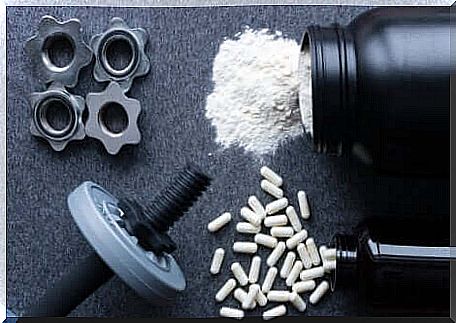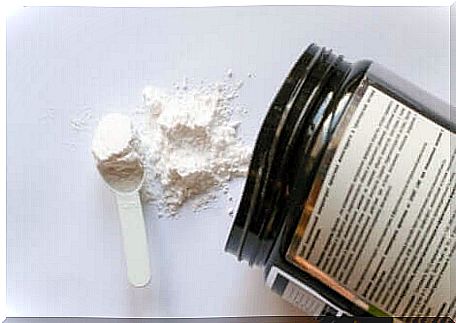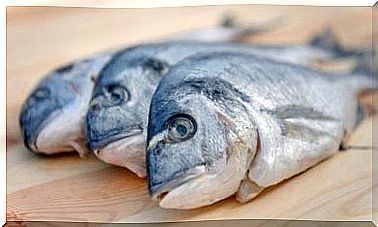Types Of Creatine: Properties And Uses
Creatine is one of the most widely used dietary supplements by athletes worldwide. If you want to find out about its types, properties and uses, this article is for you!

Currently, a large part of the world’s population participates in sport, either professionally or as a hobby. Therefore, many products have emerged to improve performance during training. One of the most popular is creatine. Today we are talking to you about the types of creatine, its properties and uses.
Creatine is a non-protein amino acid that we can find in the body. It is distributed in the muscles and, to a lesser extent, in the brain. In the diet, the best sources of creatine are red meats and seafood.
In addition, the main function of creatine is associated with the formation of ATP (substance of energy metabolism). It therefore considerably improves the performance of athletes. However, it is also used to treat some brain disorders as well as heart failure.
Types of creatine and their respective properties
Being an excellent dietary supplement, various types of creatine have appeared over the years. All vary slightly in their chemical composition in order to achieve better results. In this sense, among the different components of creatine we can mention the following.
Creatine monohydrate
It is the most used creatine supplement by athletes, as well as the purest. Indeed, the others are derivatives. It is very effective and has been shown to improve several aspects of physical training such as speed and maximum power.
In general, this component does not contain additives. 88% is creatine and the remaining 12% is water. Therefore, it has the ability to hydrate cells, decrease the damage they suffer and increase intramuscular reserves.

Creatine hydrochloride
Since it is one of the newer types of creatine, there are few studies that talk about it. However, mixing creatine with hydrochloric acid results in a stable molecule that is up to 38 times more stable with creatine monohydrate. It is therefore more easily absorbed. Its effects are the same and it is less likely to damage the kidneys.
Creatine gluconate
This dietary supplement mixes creatine with glucose molecules. So that its intestinal absorption is faster. In addition, it circulates more efficiently in the blood and penetrates more into the muscle compared to creatine monohydrate. This is because glucose generates a momentary spike in insulin.
Creatine phosphate or phosphocreatine
Phosphocreatine or creatine phosphate is a chemical component that is found in the body and provides great energy value. However, its reserves are low. It is therefore one of the most sought after types of creatine. It consists of creatine and phosphate in a 62-38 ratio.
On the other hand, it has the same functions as creatine monohydrate and is great for building lean tissue. In addition, as it is an additional source of energy, it decreases fatigue during training.
Creatine Kre-Alkalyn
Also known as alkaline creatine , it is the result of mixing creatine monohydrate and alkaline powders. The main idea of this mixture is to raise the pH of the component in order to improve its absorption and prevent the formation of creatinine, thereby reducing damage in the kidneys.
For a long time, it was believed that creatine Kre-Alkalyn offered better results than the monohydrate. However, a recent study shows that there are no significant differences in performance.
Creatine malate
In this supplement, 2 or 3 molecules of creatine are mixed with malic acid. This makes it more soluble and more easily absorbed. In addition, it is characterized by improved endurance, and potency of the athlete without affecting blood pressure and fat levels.
Creatine ethyl ester
Creatine ethyl ester is nothing other than creatine monohydrate esterified with methanol or ethanol alcohol. This esterification facilitates the passage of the component through the membranes of the muscle cells. It is therefore more rapidly absorbed and requires a lower dose.
Creatine citrate
It is the result of the mixture of 40% creatine and citric acid. It is the most soluble component of all. In addition, thanks to citric acid, it stimulates a strong production of muscle energy. As it is very soluble, it does not cause stomach pain. However, its cost is quite high.
Uses and safety of consuming types of creatine
Creatine is used by top athletes to improve their speed, endurance and strength. Indeed, its consumption is recommended for sports such as rowing, high jump and football. Its effectiveness has been proven over and over again.
On the other hand, creatine supplements are used to improve the rare syndromes of the metabolism of this amino acid, when the body is no longer able to generate it on its own. Although scientific evidence is insufficient, its oral consumption is also prescribed in cases of heart failure.
Consuming the various types of creatine is safe. Provided that it is ingested over a short period and in maximum doses of 5 grams. Nevertheless, it is always essential to consult a doctor before starting the ingestion of any dietary supplement.
Potential Benefits of Different Types of Creatine
The different types of creatine have become allies for athletes. They actually offer all the same benefits during training, including:
- Energy supply to muscle fibers.
- Increase in volume and better muscle recovery.
- Prevention of fatigue and exhaustion.
- Delay of skin aging .
The big difference between the components of creatine is their solubility. The more soluble they are, the faster their absorption. The required dose will also be lower in some cases.

Contraindications to its use
One of the first things people usually think of about consuming creatine is the possibility of kidney damage. You have to be very careful with this supplement if you already have a kidney problem. Or if there is a risk due to excess protein.
In addition, the ingestion of creatine with nephrotoxic drugs should also be avoided . That is, those who are able to affect the functioning of the kidneys. Consuming both substances can increase your risk.
Another contraindication is linked to the consumption of caffeine. These two elements should not be consumed together as the effect of the amino acid on the muscles is less due to this interaction.
Main differences between types of creatine
As you can see, the various types of creatine are very similar. They all have the same effects on muscles. In addition, scientific evidence is not sufficient to say that one component is better than another.
To conclude, the difference between these supplements lies in their soluble nature as well as their side effects. In general, creatine monohydrate derivatives are more soluble and cause less stomach upset. However, you should always consult a specialist before consuming them.









